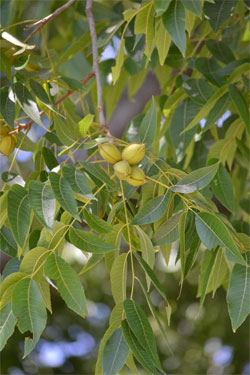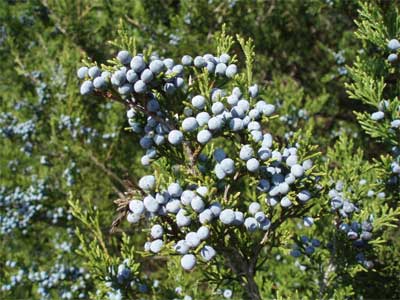Texas Tree Tips – August, 2011
What This Summer Reminded Me About Trees

While many other trees show signs of stress, pecans maintain a dark green canopy and continue producing a fall crop. All photos courtesy of Steve Houser.
It’s unusual to talk about trees without the weather coming up in the conversation. It is perfectly understandable, since much of what we do to care for trees is weather related. When asked to describe Texas weather, I can sum it up in one word: Extreme! This year proves the point — with record cold temperatures in February and unprecedented drought and high temperatures in July and August. Records have been broken day and night — literally.
This year, I was reminded that our native trees are remarkably tolerant of record-breaking temperatures. For example, if I only look at the crown of a pecan tree, and ignore its surroundings, I find nothing unusual. There may be a few less webworms in the foliage or a few more squirrel-damaged branches. But the leaves are full and dark green, and this year’s nut crop is maturing as expected and will make up for last year’s poor showing. Not until I look at a trunk tapering into a ground covered in thin brown grass, and crevasses in the black clay so large earthworms have to take a detour, do I fully realize how well our state tree is adapted to the elements. That’s when I remember — I already knew that.

As an adaptive coping technique, cottonwood trees drop leaves during periods of drought and extreme heat.
When cottonwood trees have more leaves under the canopies than in the canopies, the common thought is that these trees are not well adapted to our Texas extremes. But the contrary is true. Cottonwoods have immense root systems to support their masts of leaves. Their roots target every pore space within the tree’s reach, pulling water from the soil. When the roots can pull no more, a signal is telegraphed to the leaves to jump overboard in order to save the ship. The leaves yellow and drop. Cottonwoods place themselves in an induced dormancy in an attempt to live another year. When the rains come and these massive trees pop out a new set of leaves, I realize how well this native tree has adapted to the elements. That’s when I remember — I already knew that.

Native eastern red cedars provide food and shelter for birds during periods of extreme heat and drought.
When I see an urban landscape that gets no supplemental water, but contains an old eastern red cedar covered with purple berries and forest-green boughs, I think to myself, “How can this be?” No rain for three months and week after week of 100-degree-plus days, and this tree appears unscathed. While other trees stress, this eastern red cedar will spend the day providing food and shelter for the neighborhood’s birds. While other trees struggle until the rains come and the temperatures drop, this native evergreen doesn’t skip a beat. That’s when I remember — I already knew that.
As an arborist and a tree climber, I rarely pass up an opportunity to place a rope in a large bur oak. Lucky for me, the occasion presents itself frequently. When recently climbing an unusually large bur oak, I noticed the cooling effect as I made my way up. In addition to being in the shade, I was the beneficiary of nature’s own air conditioner. The leaves muffled the city noise, and I was eye to eye with the birds. I thought about all the extremes this native oak had endured for a few hundred years and wondered if, from the perspective of the bur oak, our extremes were not extreme at all. Once I reached the top and found my perch to survey all the treetops as far as I could see, I thought to myself, “I love trees.” That’s when I remembered — I already knew that.
About the author: Steve Houser is a Dallas native with more than 30 years of experience as a consulting arborist and tree climber. He is the president of Arborilogical Services Inc., “The Experts Your Trees Deserve.” www.arborilogical.com.
